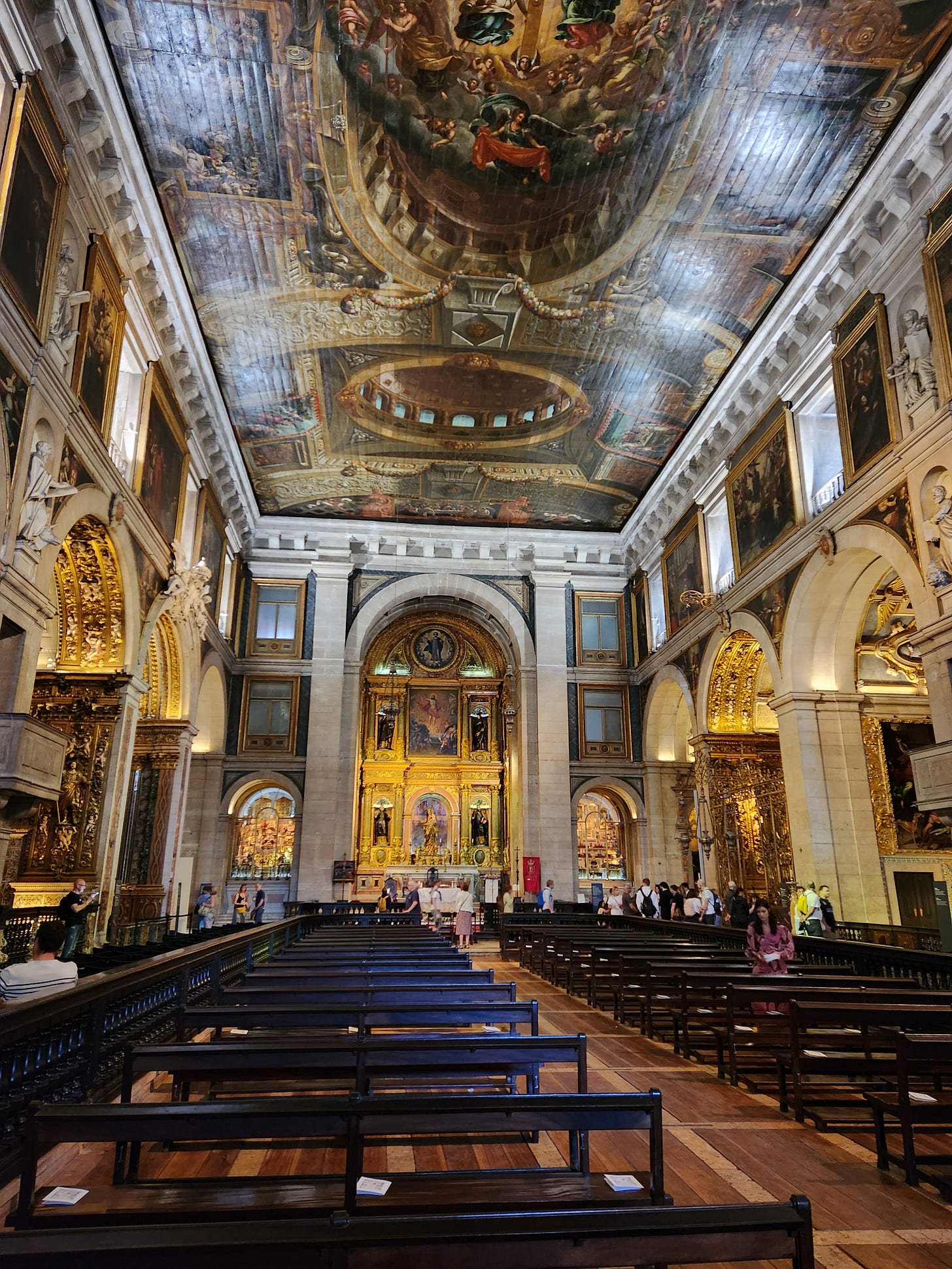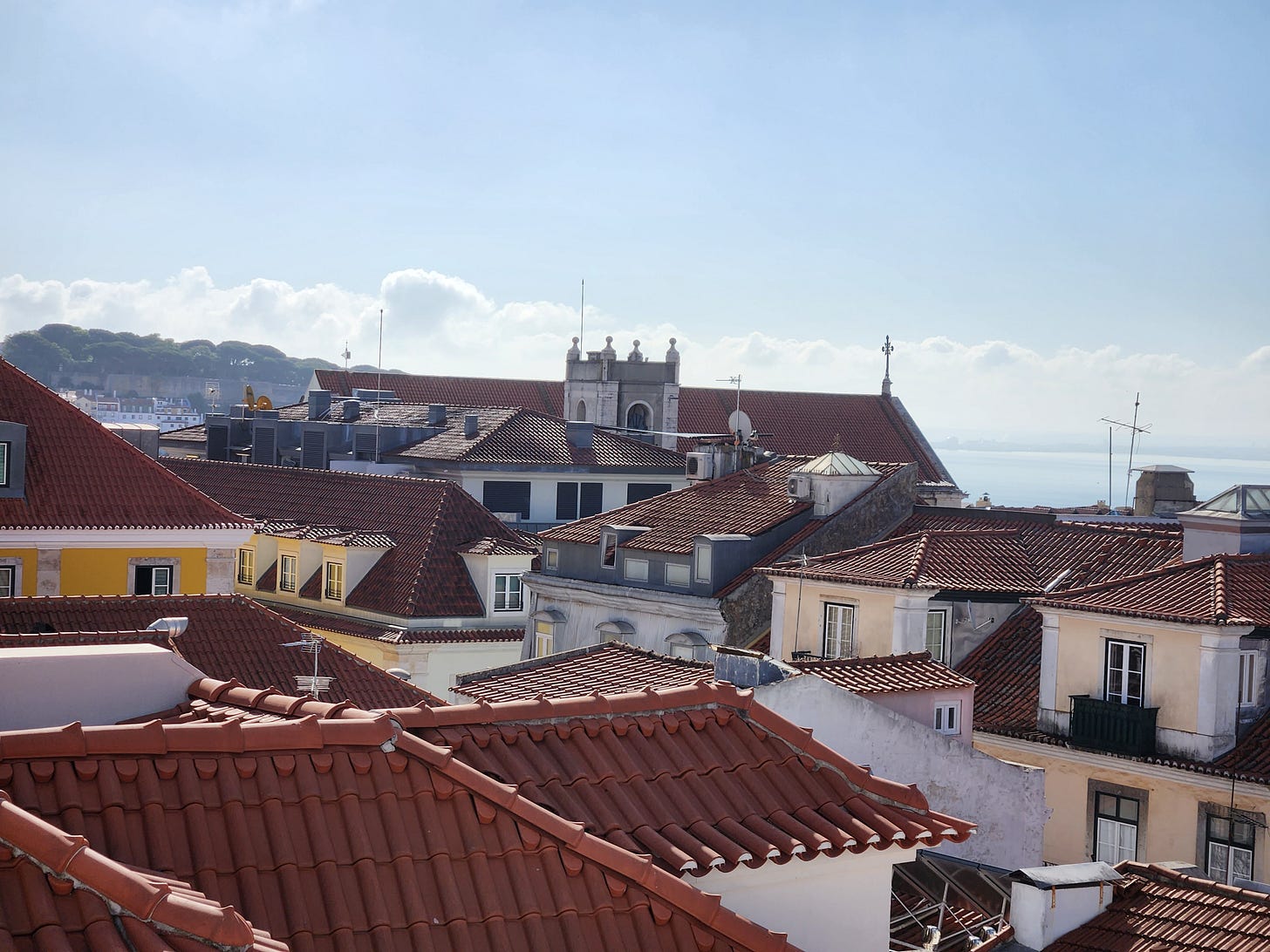"Outer beauty attracts, but inner beauty captivates"
Another gem in our neighborhood: the Igreja de Sao Roque
The quote “outer beauty attracts, but inner beauty captivates” (or a variation thereof) comes from several sources, one of which is a steamy, romantic TV series. Whatever the source, it best describes my impression of one of the major parish churches in our neighborhood: the Church of St. Roque. You can see the simple, austere facade and bell tower in the pictures. The north wall of the church looks like any other building in the area, almost resembling a wall. The simplicity of the exterior emits a beauty of its own, and the large wooden double doors seem to say “there’s something behind us that you might want to check out.” The exterior of the church, which was built by the Jesuits in the late 16th century, reflects the Jesuit insistence that the exterior of all church buildings should be plain. But, as you can see in the pictures, when you step through the west doors, it’s a very different story; captivating, to say the least. According to the travel guides, if there’s one church to visit in Lisbon, Sao Roque is it. I wouldn’t disagree.
The church is built in the Baroque style, but not in the typical pattern of most other churches in Europe which were built in cruciform, that is with a nave, transepts, and choir arranged in the shape of a cross. Although there are several side chapels, the main body of the church (seen above) resembles most Protestant churches. This is because the Jesuits built it for preaching. Interestingly, many churches in Lisbon are built in this style, especially the ones built by Jesuits. This is one of the few churches in Lisbon that survived the earthquake of 1755, almost intact. Most of the goldleaf decorations you see in the pictures were installed in the late 16th and 17th century.
The present building was built over a small chapel that housed a relic of Sao Roque, the patron saint of infectious diseases. King Manuel I had the shrine built and the relic installed in the hope of warding off the Black death plague. Unfortunately for Lisbon, it didn’t help much as the city was devasted by the plague.

So, who was Sao Roque (St. Roque)? Ready for a sad story? Roque was born to a wealthy family in Montpellier, France around 1348. His parents died when he was a teenager, leaving him as the sole heir to a fortune. Following the example of St. Francis of Assisi, he gave away much of his wealth to the poor and made a pilgrimage to Rome as a beggar. Upon reaching Italy, which was in the throes of the deadly plague, he cared for the sick and dying. When he became ill, he went into a forest, built a small hut, and waited to die. The legend goes that the dog of an Italian count brought him bread each day and licked his wounds. Miraculously, he recovered; thanks to the healing powers of the dog’s tongue.
He returned to his home town, whereupon he was mistaken for an Italian spy, thrown in jail, and in the 5th year of his incarceration, died. It was only after his death that his identity as the heir was revealed. As his body was taken from the prison, the jailer noticed a birthmark in the shape of a cross. Evidently, the folks in Montpellier knew about the mark because his parents, especially his mother, had made such a big deal of it. Why he didn’t reveal the birthmark and his identity at his trial is beyond me. In any case, he was venerated by the local people and later Pope Gregory XIV made him an official saint of the Roman Catholic Church. He is not only the patron saint of infectious diseases but of dogs. Perhaps I should take Abi, our lab, to the church more often to see if she can be healed of her obsession with jumping on and licking every human who gives her just the slightest attention.
Back to the church. Even as I’m writing this post, the church bells are ringing the hour. Since the bell tower is about the same height as our apartment, we have a straight visual shot of the tower from our second level. That also means that the sound of the bells have a straight shot to our apartment! When it’s quiet on our street, like it is right now, it sounds like they’re right outside the window. For some reason, the bells chime the hour, the half, and each quarter hour about 1-2 minutes behind real time. I’m not sure if that’s a defect in the bell mechanism or intentional, since the bells of the cathedral ring exactly on the hour. Do the cathedral bells take precedence? (I just heard the bells of another church down in the Chiado chiming the hour, about 5 minutes late.) In any case, it’s charming. Sometimes it’s surreal. I never dreamed I’d be living in the heart of a European city. Like the life of Sao Roque, you never know where life’s journey will take you! Let’s just pray it doesn’t lead to our demise in a jail cell like poor Roque of Montpellier.







Beautiful church, enriched by the story of the saint.
Beautiful, thank you. Added to our list of sites to see once we're settled.